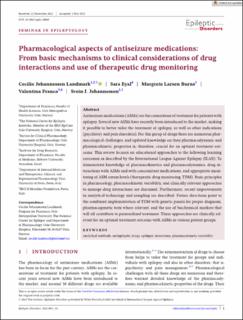| dc.description.abstract | Antiseizure medications (ASMs) are the cornerstone of treatment for patients with epilepsy. Several new ASMs have recently been introduced to the market, making it possible to better tailor the treatment of epilepsy, as well as other indications (psychiatry and pain disorders). For this group of drugs there are numerous phar- macological challenges, and updated knowledge on their pharmacodynamic and pharmacokinetic properties is, therefore, crucial for an optimal treatment out- come. This review focuses on educational approaches to the following learning outcomes as described by the International League Against Epilepsy (ILAE): To demonstrate knowledge of pharmacokinetics and pharmacodynamics, drug in- teractions with ASMs and with concomitant medications, and appropriate moni- toring of ASM serum levels (therapeutic drug monitoring, TDM). Basic principles in pharmacology, pharmacokinetic variability, and clinically relevant approaches to manage drug interactions are discussed. Furthermore, recent improvements in analytical technology and sampling are described. Future directions point to the combined implementation of TDM with genetic panels for proper diagnosis, pharmacogenetic tests where relevant, and the use of biochemical markers that will all contribute to personalized treatment. These approaches are clinically rel- evant for an optimal treatment outcome with ASMs in various patient groups. | en_US |

